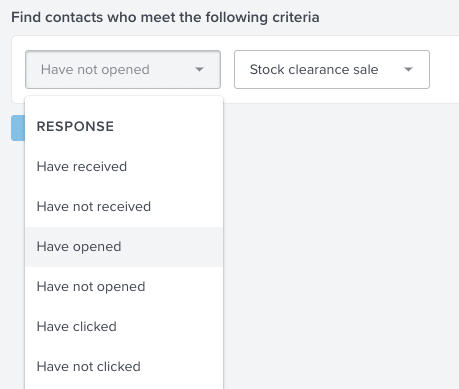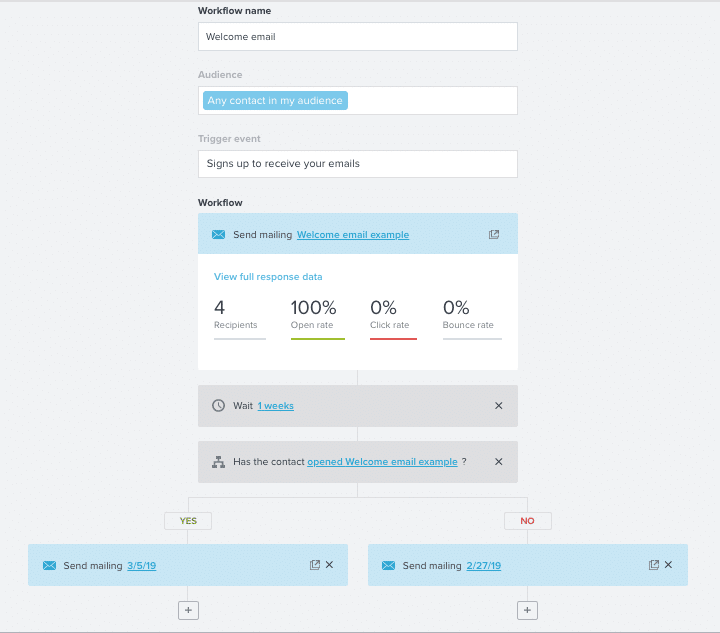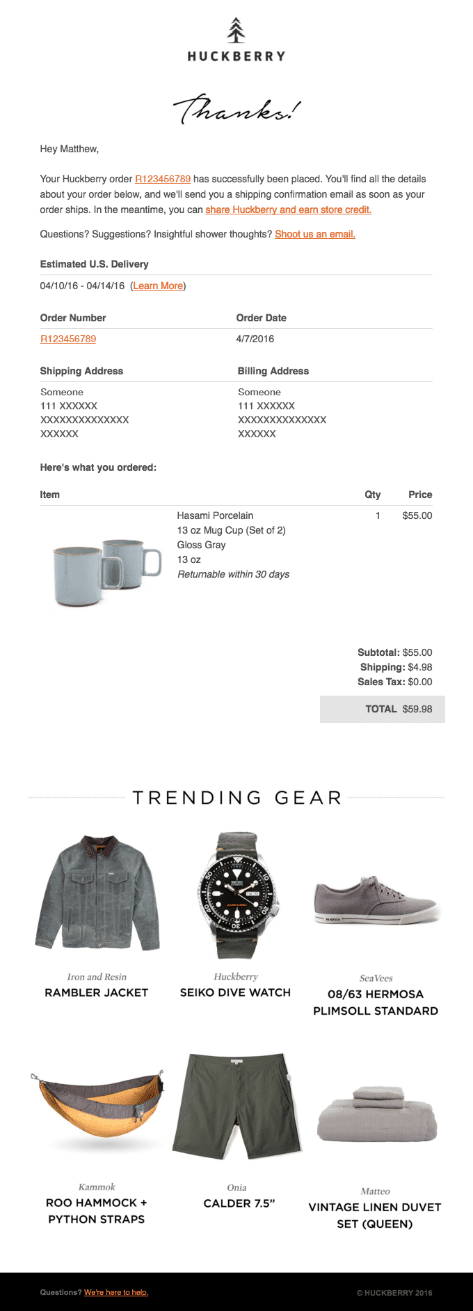The basics of triggered emails (with examples)
When someone visits your site, there’s more than a 95% chance they aren’t ready to buy. But don’t worry — by nurturing your subscribers, you can eventually see them convert.
Nurturing is important for guiding new leads toward a purchase and keeping current customers happy.
Nearly 85% of consumers and 83% of business buyers say the key to winning their business is treating them like humans rather than just a number.
Triggered emails rely on automation to provide a unique experience for every subscriber. Instead of generic email blasts, every subscriber gets personalized content based on their browsing behavior and actions they take.
This post will go over the basics of triggered emails, how they work, and how to set them up. It will also provide examples to see what triggered emails look like in action.
What are triggered emails and how do they work?
Let’s get basic definitions out of the way.
When we talk about “triggered” emails, the trigger is an action. Actions include:
-
Visiting a landing page
-
Reading a specific blog
-
Downloading a lead magnet
-
Browsing a product page
-
Buying a product or service
-
Signing up for a list
-
Becoming inactive
-
Running out of a product
Let’s say someone visits a product page on your website. If they’re subscribed to your email list, viewing the product page would trigger a follow-up email. You might ask them what they thought about the product or simply remind them of it.
You can also send triggered emails for inactivity. If a customer hasn’t visited your website in three months, you could set up an automated email to ask where they’ve been.
Triggered emails rely on automation. You don’t send them manually — that’s the beauty of technology. Instead, you design the emails ahead of time. Artificial intelligence (AI) sends them out automatically based on the triggers you set up in your email service provider.
Why you should consider using triggered emails
Triggered emails are highly personalized. Personalized emails are naturally more relevant to your subscribers.
That’s why triggered campaigns deliver 119% higher click rates than standard broadcast emails.
Why?
First, the content inside the email is highly relevant because it’s based on the subscriber’s behavior and preferences. Because of their automatic nature, these triggered emails are extremely timely as well.
Triggered emails allow you to build a conversation with your customers. Unlike other emails, they’re not one sided. Instead, they rely on input and reactions from your subscribers. These are simply your response to a subscriber’s activity.
How to set up triggered emails
Now that you understand how triggered emails work and why they’re valuable, it’s time to get started.
With Emma, it just takes a few steps to set up your triggered emails. Here’s how.
Filter your audience
First, set up audience segments. Normally, you would create segments based on demographics like age, gender, or location. In this case, however, you’re creating a segment to determine who receives your triggered emails.
For example: You might set up one segment for current customers and another for leads.
You can also filter your audience to move subscribers out of specific segments after they finish an action. As an example, if a subscriber downloads a lead magnet, they won’t continue receiving emails to download the item. Instead, they could move into another segment prompting them to visit a specific landing page or browse a product.
Source: Emma
Decide on your triggered events
Now it’s time to decide what actions will trigger an email. What event will happen that will cause each segment to receive an email campaign?
You can also use dates as triggered events. Birthdays, anniversaries, or holidays can all trigger automated emails.
You might choose actions like:
-
Purchasing a product
-
Downloading a lead magnet
-
Viewing a specific page on your site
-
Signing up for your email list
-
Clicking a specific link in an email
You can also use automation to re-engage dormant subscribers.
Design your campaigns
Once you decide on your triggered events or dates, you can start designing your emails.
Here’s the beauty of automation and AI: You only have to design and write copy for a handful of email templates.
Once you have your templates, AI creates dynamic content automatically. For example, each customer will receive a different product confirmation email containing an image of the product they purchased along with their personal information.
Create workflow steps
During this stage, you’ll be creating customer journeys.
You might start the journey with a welcome email. Once they engage with this email, AI will analyze their behavior and adjust future emails accordingly.
If you include two links in your welcome email, AI and machine learning will take note of which one a subscriber clicks. This is called a “branch.” You can set up unique branches for different topics and behaviors.
These branches are the keys to providing a unique customer journey for each subscriber.
Keep in mind that once the workflow begins, AI takes complete control. You can’t alter the types of triggers or time in between. You can, however, adjust the subject lines, content, and other high-level information.
Of course, subscribers will still be able to unsubscribe in accordance with spam laws.
Source: Emma
How to determine the effectiveness of your triggered emails
Once you set up your workflows and start sending triggered emails, you’ll want to figure out if they’re working. In other words, are people engaging with them and converting?
You can log into your Emma dashboard and easily track the results on both a micro and macro level. For example, you can monitor individual subscribers to see if and how they’re opening your emails and clicking links.
You can also track the results of specific workflows. Look for areas subscribers go dark and stop engaging to improve any inefficiencies. Could you have worded your content in a more interesting way or provided a more engaging call to action (CTA)?
You’ll want to check your:
-
Open rate: What percentage of people are opening each campaign or workflow?
-
Click rate: How many people are clicking links inside each campaign? Which links are they clicking?
-
Click-to-open rate: What percentage of people who open your email also click a link inside?
As always, you can also monitor the results of your entire email marketing strategy across all campaigns.
5 triggered email examples to inspire you
You’ve likely received emails you didn’t know were sent as a result of triggered events. Targeted promotions and curated blog content, for example, aren’t quite as obvious as transactional emails.
Use these triggered email examples as inspiration to explore the possibilities.
1. Welcome emails
Welcome emails provide a 50% open rate on average. Use this to your advantage and optimize them. A few options include:
-
Sending a personal note signed by your head of marketing or sales
-
Providing a list of resources such as FAQs, tutorials, or case studies
-
Asking the subscriber to set up their preference center
-
Explaining your mission, brand values, and how you help the community
Source: Gmail
2. Transactional emails
Transactional emails tend to provide six times more revenue and eight times more engagement than other email types. After all, almost everyone opens their order confirmation emails.
Take advantage of this by optimizing your transactional emails with personalized upsells, add ons, or tutorials.
Source: Really Good Emails
3. Targeted promotions
Set up triggered emails with targeted promotions using customer behavior from your website analytics. Keep the conversation going long after subscribers have left your website. Send a relevant email with a custom coupon based on a specific product page they visited.
Source: Gmail
4. Curated blog content
Your newsletters don’t need to be generic. Use customer behavior from your website and your email analytics to send specially curated newsletter content.
You can also ask your subscribers to set up an email preference center. Have them select their favorite topics to learn about. They can also decide how often they’d like to receive emails from you and which types of emails they prefer.
Source: Milled
5. Birthday messages
Everyone loves to feel appreciated on their birthday.
Birthday emails can help you drive some serious return on investment (ROI). On average, a birthday message can produce 481% higher conversion rates, 342% more revenue, and 179% unique click rates.
Optimize your birthday emails with stunning designs, discount codes, or gifts.
Source: Really Good Emails
Wrap up
Triggered emails help you build a relationship with your subscribers through highly personalized content. Instead of one-sided generic emails, you can build conversations based on subscriber activity. Triggered emails allow you to set up unique customer journeys.
When setting up your triggered email campaign, remember to:
-
Filter your audience segments to decide who gets the triggered emails
-
Decide which actions will trigger emails
-
Set up workflows — and branches for subscribers to engage with — through AI
-
Monitor the results of your campaigns and tweak as necessary
-
Browse triggered email examples for inspiration
Want more triggered email examples? Check out our email library to see what’s possible with the power of automation.
MOST RECENT ARTICLES
Want to engage your audience and grow your brand? Try Emma's robust easy-to-use product today.




















